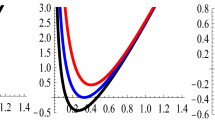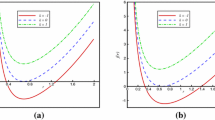Abstract
For the \((n+1)\)-dimensional (\(n\ge 3\)) dilaton black hole in the Einstein–Maxwell-dilaton theory, we have presented exact analytical solutions of the field equations. These exact solutions include the exact formula of the potential function as well as the exact formula of the metric function. The presence of the dilaton field makes the asymptotic behavior of these black holes no longer flat or anti-de Sitter. We have calculated the electric charge, mass, temperature, entropy and electric potential of these black holes and have shown the correctness of the first law of black hole thermodynamics. As a thermodynamic system, we have analyzed thermal stability of these types of black holes using the canonical ensemble method and, investigated the effect of dilaton field on their stability.



Similar content being viewed by others
Data Availability
No datasets were generated or analysed during the current study
References
Bekenstein, J.D.: Contemp. Phys. 45, 31 (2004)
Hawking, S.W.: ar**v:1509.01147v1 [hep-th] (2015). Phys. Rev. D 13, 191 (1976)
Bekenstein, J.D.: Scholarpedia, 3 (2008) 7375. Phys. Rev. D 7, 2333 (1973)
Custodio, P.S., Horvath, J.E.: Am. J. Phys. 71, 1237 (2003)
Opatrny, T., Richterek, L.: Am. J. Phys. 80, 66 (2011)
Wald, R.M.: Living Rev. Relat. 4, 6 (2001)
Wallace, D.: Entropy 16, 699725 (2014)
Hendi, S.H., Eslam Panah, B., Panahiyan, S., Momennia, M.: Eur. Phys. J. C 75, 507 (2015)
Dehghani, M.: Phys. Rev. D 106, 084019 (2022)
Nojiri, S., Odintsov, S.D.: Phys. Rep. 505, 59 (2011)
Nojiri, S., Odintsov, S.D.: Phys. Rev. D 77, 026007 (2008)
De Felice, A., Tsujikawa, S.: Living Rev. Relat. 13, 1 (2010)
Sotiriou, T.P., Faraoni, V.: Rev. Mod. Phys. 82, 451 (2010)
Bihan, L.B.: Euro. J. Phil. Sci. 10, 17 (2020)
Dehghani, M.: Eur. Phys. J. Plus 134, 426 (2019)
Sheykhi, A., Hendi, S.H.: Phys. Rev. D 90, 044028 (2014)
Dvali, G., Gabadadze, G.: Phys. Rev. D 63, 065007 (2001)
Sheykhi, A.: Phys. Rev. D 76, 023515 (2007)
Dehghani, M., Setare, M.R.: Phys. Rev. D 100, 044022 (2019)
Hajkhalili, S., Sheykhi, A.: Phys. Rev. D 89, 104019 (2014)
Dehghani, M.: Int. J. Mod. Phys. D 27, 1850073 (2018)
Hirschmann, E.W., Lehner, L., Liebling, S.L., Palenzuela, C.: Phys. Rev. D 97, 064032 (2018)
Charmousis, C.: Class. Quantum Grav. 19, 83 (2002)
Richarte, M.G., Martins, E.L., Fabris, J.C.: ar**v:2111.01595 [gr-qc], (2021)
Sheykhi, A., Dehghani, M.H., Kord Zangeneh, M.: Eur. Phys. J. C 75, 497 (2015)
Dehghani, M.: Prog. Theor. Exp. Phys., 2023 (2023) ptad128
Kord Zangeneh, M., Dehghani, M.H., Sheykhi, A.: Phys. Rev. D 92, 104035 (2015)
Hendi, S.H., Eslam Panah, B., Panahiyan, Sh.: Eur. Phys. J. C 77, 133 (2017)
Dehghani, M.: Phys. Rev. D 97, 044030 (2018)
Dehghani, M.: Phys. Rev. D 99, 104036 (2019)
Dehghani, M., Hamidi, S.F.: Phys. Rev. D 96, 104017 (2017)
Kord Zangeneh, M., Sheykhi, A., Dehghani, M.H.: Phys. Rev. D 91, 044035 (2015)
Dehghani, M.: Phys. Lett. B 749, 125 (2015)
Hendi, S.H., Katebi, R.: Eur. Phys. J. C 72, 2235 (2012)
Eslam Panah, B., Hendi, S.H., Panahiyan, Sh., Hassaine, M.: Phys. Rev. D 98, 084006 (2018)
Hawking, S.W., Hunter, C.J.: Phys. Rev. D 59, 044025 (1999)
Dehghani, M.: Prog. Theor. Exp. Phys., 2023 (2023) ptad033
Cvetic, M., Gubser, S.S.: JHEP 04, 024 (1999)
Hendi, S.H., Sheykhi, A., Panahiyan, S., Eslam Panah, B.: Phys. Rev. D 92, 064028 (2015)
Dehghani, M.: Eur. Phys. J. C 83, 987 (2023)
Hendi, S.H., Panahiyan, S., Eslam Panah, B., Momennia, M.: Eur. Phys. J. C 75, 507 (2015)
Hendi, S.H., Ramezani-Arani, R., Rahimi, E.: Eur. Phys. J. C 79, 472 (2019)
Dehghani, M.: Int. J. Mod. Phys. A 38, 2350063 (2023)
Author information
Authors and Affiliations
Contributions
All authors reviewed the manuscript and wrote the main manuscript.
Corresponding author
Ethics declarations
Conflict of interest
The authors declare no competing interests.
Additional information
Publisher's Note
Springer Nature remains neutral with regard to jurisdictional claims in published maps and institutional affiliations.
Appendices
Appendix A: details of derivation of Eq.(12)
In order to prove the non-independence of Eqs. (8), (9) and (II.10), we start by differentiating Eq. (10) with respect to r:
On the other hand, according to Eq. (7), we can write \(2F_{tr}^{2}e^{-\frac{4\alpha \phi }{n-1}}=2q^{2}\frac{e^{\frac{4\alpha \phi }{n-1}}}{(rR)^{2(n-1)}}\) which leads to
It is also obtained from the (II.3) and (II.9) that
and
The point is that, it is possible to replace \(f''\) from Eq. (8):
As a result, with a little calculation and simplification, we can write
Appendix B: details of derivation of Eq. (31)
To calculate the mass of the black hole, we use the following method. First, it is necessary to write the black hole metric in the new form below
where \(\rho =rR(r)\). From the comparison with the original metric, it follows that \(\chi ^{2}(\rho )=f(r)\) and \(W^{2}(\rho )=(N+1)^{2}R^{2}f(r)\). The quasi-local mass of the black hole is defined according to the following relation:
where \(W_{0}\equiv W(m=0)\). In the following, it is better to write f(r) in the appropriate form below
where \(u(r)=Ar^{-2N}+Br^{2(N+1)}+Cr^{-2[(n-1+\alpha \varepsilon )(N+1)-1]}\) which is expressed based on Eq. (20). We pay attention that according to the interval defined for N as \(-1< N\le 0\), whether by choosing \(-1<N<-\frac{1}{2}\) or \(-\frac{1}{2}<N\le 0\), at the limit \(r\rightarrow \infty \) one term has a constant value and the other term diverges. The third term also becomes zero in any case, and therefore the total limit of the fraction will be zero. According to these points, it can be stated that
Now, one can obtain the black hole mass M, by calculating the limit of \(\mathcal {M}\) as r goes to infinity. Since, for the allowed values of N,
we can write
Also, noting Eq. (20), we can write
where \(v(r)=B_1\frac{r}{r_{0}}\left[ \ln \left( \frac{b}{r}\right) +\frac{n+1}{n-1}\right] +B_2\frac{r}{b}+B_3r^{-(n-3+\alpha )}\) which is written according to the second rule of Eq. (20). As with the calculations related to the previous state, we can also write here
which in turn will lead to
Rights and permissions
Springer Nature or its licensor (e.g. a society or other partner) holds exclusive rights to this article under a publishing agreement with the author(s) or other rightsholder(s); author self-archiving of the accepted manuscript version of this article is solely governed by the terms of such publishing agreement and applicable law.
About this article
Cite this article
Baghbani, R., Dehghani, M. New exact solutions, thermodynamics and phase transition in the Einstein–Maxwell-dilaton theory. Gen Relativ Gravit 56, 77 (2024). https://doi.org/10.1007/s10714-024-03266-0
Received:
Accepted:
Published:
DOI: https://doi.org/10.1007/s10714-024-03266-0




